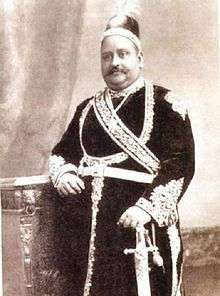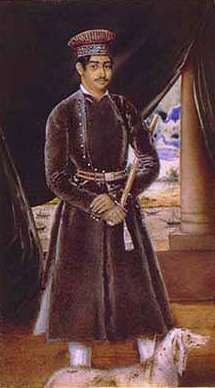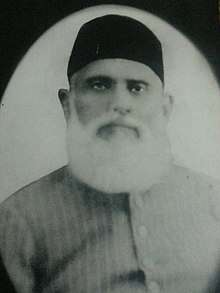Zamindar

A zamindar in the Indian subcontinent was an aristocrat. The term means land owner in Persian. Typically hereditary, zamindars held enormous tracts of land and control over their peasants, from whom they reserved the right to collect tax on behalf of imperial courts or for military purposes. Their families carried titular suffixes of lordship, such as Babu, Sri, Rai, Pillai, Rao, Chaudhuri, Khan, Sardar, Malik, Thakur, Wadero, Reddy, Thevar and Naidu. In the 19th and 20th centuries, with the advent of British imperialism, many wealthy and influential zamindars were bestowed with princely and royal titles such as Maharaja (Great King), Raja (King) and Nawab.
During the Mughal Empire, zamindars belonged to the nobility[1] and formed the ruling class. Emperor Akbar granted them mansabs and their ancestral domains were treated as jagirs.[2] Under British colonial rule in India, the permanent settlement consolidated what became known as the zamindari system. The British rewarded supportive zamindars by recognizing them as princes. Many of the region's princely states were pre-colonial zamindar holdings elevated to a greater protocol. However, the British also reduced the land holdings of many pre-colonial aristocrats, demoting their status to a zamindar from previously higher ranks of nobility.
The system was abolished during land reforms in East Bengal (Bangladesh) in 1950,[3] India in 1951[4] and West Pakistan in 1959.[5]
The zamindars often played an important role in the regional histories of the subcontinent. One of the most notable examples is the 16th century confederation formed by twelve zamindars in the Bhati region, which, according to the Jesuits and Ralph Fitch, earned a reputation for successively repelling Mughal invasions through naval battles. The confederation was led by a zamindar-king, Isa Khan, and included both Muslims and Hindus, such as Pratapaditya. The zamindars were also patrons of the arts. The Tagore family produced India's first Nobel laureate in literature in 1913, Rabindranath Tagore, who was often based at his estate. The zamindars also promoted neoclassical and Indo-Saracenic architecture.
Mughal era

Before Mughal rule in India, the aristocracy collected and retained revenue from land and production. The Mughals appointed people to act as tax officers, sending them around the country to oversee collection of revenue and remit it to the capital city of Delhi.[6] These people were known as the zamindari (intermediaries)[7] and they collected revenue primarily from the Ryots (peasants)[8] The zamindari system was more prevalent in the north of India because Mughal influence in the south was less apparent.[7]
Primary and secondary zamindars were a landowning class with superior rights in the land, but working as part of the Mughal administration for the collection of land revenue. The third category was of autonomous and semiautonomous rulers. These hereditary rulers were known by various names such as Rais, Rajas, Ranas, and Rawals.[9]
The zamindari system ensured proper collection of taxes in a period when the power and influence of the Mughal emperors were in decline. With the Mughal conquest of Bengal, "zamindar" became a generic title embracing people with different kinds of landholdings, rights and responsibilities ranging from the autonomous or semi-independent chieftains to the peasant-proprietors. All categories of zamindars under the Mughals were required to perform certain police, judicial and military duties. Zamindars under the Mughals were, in fact, more the public functionaries than revenue collecting agents. Although zamindaris were allowed to be held hereditarily, the holders were not considered to be the proprietors of their estates.
The territorial zamindars had judicial powers also. This conferred status with attendant power, which really made them the lords of their domains. They held regular courts, called zamindari adalat. The courts gave them not only power and status but some income as well by way of fines, presents and perquisites. The petty zamindars had some share in the dispensation of civil and criminal justice. The Chowdhurys, who were zamindars in most cases, had authority to deal with the complaints of debts, thefts and petty quarrels and to impose paltry fines.
Raja Narayan Singh ( Dada narayan singh
Narayan singh was Born at Formerly princely state of Jigni, he was educated at Mayo college, Jaipur, he also served as Tahsildar in British india, In 1930 he was rewarded by the title of "raja" by britishers. Narayan Singh was populary known as Narayan Singh
British era

The British colonists of India generally adopted the extant zamindari system of revenue collection in the north of the country. They recognised the zamindars as landowners and in return required them to collect taxes. Although some zamindars were present in the south, they were not so in large numbers and the British administrators used the ryotwari (cultivator) method of collection, which involved selecting certain farmers as being land owners and requiring them to remit their taxes directly.[7]
The Zamindars of Bengal were influential in the development of Bengal. They played pivotal part during the Indian Rebellion of 1857.[10]
Accession
Unlike the autonomous or frontier chiefs, the hereditary status of the zamindar class was circumscribed by the Mughals, and the heir depended to a certain extent on the pleasure of the sovereign.[11] Heirs were set by descent or a times even adoption by religious laws.[12] Under the British Empire, the zamindars were to be subordinate to the crown and not act as hereditary lords, but at times family politics was at the heart of naming an heir.[13] At times, a cousin could be named an heir with closer family relatives present;[14] a lawfully wedded wife could inherit the zamindari if the ruling zamindar named her as an heir.[15][16]
Abolition
The zamindari system was mostly abolished in independent India soon after its creation with the first amendment to the constitution of India which amended the right to property as shown in Articles 19 and 31.[17] This allowed the states to make their own "Zamindari Abolition Acts". In Bangladesh, the East Bengal State Acquisition and Tenancy Act of 1950 had a similar effect of ending the system.
See also
References
- ↑ Metcalf, Barbara Daly (1984). Moral conduct and authority: the place of adab in South Asian Islam. University of California Press. p. 269.
- ↑ Acharya, Shreya. "Give an account of the Ruling Classes of Mughal Empire". www.preservearticles.com. Archived from the original on 2013-05-21.
- ↑ Baxter, C (1997). Bangladesh, from a Nation to a State. Westview Press. p. 72. ISBN 0-8133-3632-5.
- ↑ "Abolition of Zamindari in India - General Knowledge Today". www.gktoday.in. Archived from the original on 2016-11-30.
- ↑ Newspaper, From the (11 October 2010). "Land reforms in Pakistan". dawn.com. Archived from the original on 30 November 2016.
- ↑ Hansen, Valerie; Curtis, Kenneth R. "The Politics of Empire in Southern and Eastern Asia". Voyages in World History, Volume 2: Since 1500. p. 461.
- 1 2 3 Jaffrelot, Christophe (September–October 2000). "Sanskritization vs. Ethnicization in India: Changing Indentities and Caste Politics before Mandal". Asian Survey. 40 (5): 756–766. doi:10.1525/as.2000.40.5.01p0100d. JSTOR 3021175.
- ↑ Habib, Irfan (2000) [1963]. The Agrarian System of Mughal India, 1526-1707 (2nd revised ed.). Oxford University Press. ISBN 0-19-562329-0. For the meanings of zamindar see pp. 140ff.
- ↑ Khan, Ahsan Raza (1977). Chieftains in the Mughal Empire during the reign of Akbar. Simla.
- ↑ "Patriotic And Comprador Zamindars In The Great Rebellion Of 1857". pd.cpim.org. Archived from the original on 2012-05-05.
- ↑ Islam, Sirajul; Akhter, Shirin (2012). "Zamindar". In Islam, Sirajul; Jamal, Ahmed A. Banglapedia: National Encyclopedia of Bangladesh (Second ed.). Asiatic Society of Bangladesh. Archived from the original on 2015-07-03.
- ↑ The Indian Law Reports: Madras series. Controller of Stationery and Print. 1888. p. 385.
- ↑ McLane, John R. (2002). Land and Local Kingship in Eighteenth-Century Bengal. Cambridge University Press. p. 223. ISBN 978-0-521-52654-8.
- ↑ Madras High Court Reports: 1870 and 1871. J. Higgingbotham. 1872. p. 209.
- ↑ Great Britain. Privy Council. Judicial Committee.; India. Courts. (1908). "Kashi Prasad v. Indar Kunwar". Allahabad Law Journal. Indian Press. 5: 596.
- ↑ Woodman, Joseph Vere; Monnier, Emile Henry (1902). A Digest of Indian Law Cases: Containing High Court Reports, 1862-1900, and Privy Council Reports of Appeals from India, 1836-1900, with an Index of Cases. Volume III: J-M. Superintendent of Government Printing, India. p. 5498.
- ↑ Guha, Ramachandra (2011). India After Gandhi. Ecco. pp. 219–220. ISBN 978-0-330-54020-9.